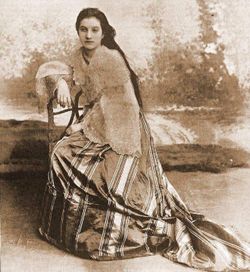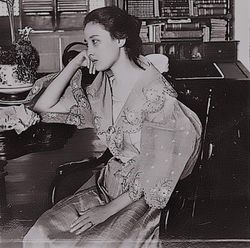Sep 18, 2024
Teenage Filipina in 1910

DID YOU KNOW?
TEENAGE FILIPINO GIRLS IN THE 1900s
During the ancient times through the early 1900s Philippines, pursuing a romantic relationship with a Filipino woman was a complex and demanding process. In line with traditional customs, men were expected to labor for the woman's family before marriage, a custom termed servitude.
This obligation could involve arduous tasks such as chopping wood and fetching water, and it could extend for months or even years as the man endeavored to convince the woman's parents of his worthiness. Remarkably, this courtship persisted even after the wedding.
Furthermore, the man was required to provide a considerable dowry, often in the form of land, gold, or property. Particularly if the man sought the hand of a chief's daughter, the stipulated dowry amount could be quite substantial. In various regions, the dowry was customarily presented to the mother-in-law and withheld until the couple had children.
In addition to the dowry, there were other anticipated payments and offerings, including "pangmuyat" (a token of gratitude for the mother's efforts in raising the girl), "breastfeeding" (compensation for the woman who nursed the man in his infancy), and "himaraw" (reimbursement for the expenses incurred in the girl's upbringing). Moreover, in certain areas, it was customary to give a bribe known as "sambon" to the woman's relatives.
Preceding the wedding, a practice referred to as "pamulungan" or "pamalae" was observed, providing an occasion for the parents of the couple to convene, finalize arrangements, and address any financial matters.
***This information is derived from the historical account in Teodoro Agoncillo's writings on Philippine history.
#PhilippineHistory #cctohistorian


1st Photo
Description:Filipino woman with traditional Maria Clara dress of the Philippines and the long hair old tradition of women in the Philippines
Date: 9 September 1890
Source : Britannica Encyclopedia Online
Author: Irishandys
2nd Photo:
Filipino woman of colonial era
Date: 9 September 1898
Source : Britannica Encyclopedia Online
Author: Francinehihao
Fashion and clothing in the Philippines refers to the way the people of Filipino society dress up in instances such as while they are at home, at work, travelling and when attending special occasions.
The clothing style and fashion sense of the Filipinos in the modern-day era have been influenced by their native ancestors: their Spanish colonizers (the Philippines was a colony of the Spanish Empire for around 333 years), the Americans (the Philippines was a territory of the United States for about 46 years), and even the Japanese (Japanese soldiers occupied the Philippines during World War II for 4 years), as evidenced by the chronology of events that occurred in Philippine history.[1] At present, Filipinos conform their way of dressing, in addition to the above factors, as a result of the influence of what is shown by the media on television fashion shows, among others.
Apart from "colonial influences" and "media influence", the Filipino style of clothing had been dictated by the climate in the Philippines. With a tropical climate (dry and rainy seasons), early Filipinos – as well as the still extant tribal groups in the Philippines – wore colorful woven clothes, often with "intricate beadwork" and other ornaments. Other items of native clothing during pre-Spanish Philippines were the canga and the bahag. The canga is a type of a collarless shirt – which later became adorned with laces, trimmings, buttons, and a collar – was where from the Barong Tagalog evolved. On the other hand, the bahag was a type of loincloth or G-string.
Present-day Filipinos, due to climatic reasons, prefer to wear T-shirts combined with maong (jeans) trousers for men and skirts for women. The "jeans and T-shirts" combination was introduced to the Filipinos by the Americans.
A common attire while at home are ordinary puruntongs (singular: puruntong, a type of pair of shorts or Capri pants) combined with sleeveless shirts or T-shirts. During the rainy season and cold evenings in December and January, some Filipinos wear hooded jackets.
By undefined
5 notes ・ 2 views
English
Intermediate